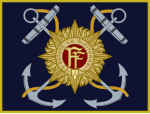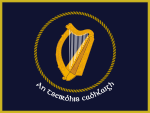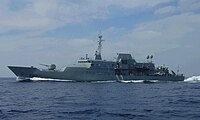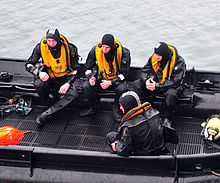This is an old revision of this page, as edited by Yobot (talk | contribs) at 05:58, 28 August 2015 (WP:CHECKWIKI error fixes using AWB (11403)). The present address (URL) is a permanent link to this revision, which may differ significantly from the current revision.
Revision as of 05:58, 28 August 2015 by Yobot (talk | contribs) (WP:CHECKWIKI error fixes using AWB (11403))(diff) ← Previous revision | Latest revision (diff) | Newer revision → (diff)
| Naval Service An tSeirbhís Chabhlaigh | |
|---|---|
 Emblem of the Naval Service Emblem of the Naval Service | |
| Founded | 1 September 1946 |
| Country | |
| Size | 994 personnel 7 ships |
| Part of | |
| Naval Base | Haulbowline, County Cork, Ireland |
| Colours |   |
| Commanders | |
| FOCNS | Commodore Hugh Tully |
| Insignia | |
| Naval ensign |  |
| Naval jack |  |
The Naval Service (Template:Lang-ga) is the branch of the Irish Defence Forces responsible for the naval operations of the state of Ireland As of 2015, the Naval Service consists of 994 personnel and 7 patrol vessels. Its base is in Haulbowline, County Cork.
Ireland's maritime defence was maintained by a number of differently named organisations since its founding in 1922, the modern Naval Service was formed in 1946. Since the 1970s a major role of the Naval Service has been the provision of fisheries protection in Ireland's exclusive economic zone (EEZ). Other roles include sea patrol, surveillance, and smuggling prevention. Occasionally the Service undertakes longer missions in support of other elements of the Defence Forces, Irish peacekeepers serving with the United Nations, or humanitarian and trade missions.
LÉ Eithne is the current flagship of the Naval Service.
History

Coastal and Marine Service
The Anglo-Irish Treaty of 1921 stipulated that the Irish Free State would be given responsibility to police its customs and fishing, while the United Kingdom would remain in control of Irish Waters. In 1923 the Coastal and Marine Service (CMS) was created, yet merely one year later it was disbanded.
During the Civil War, in August 1922, a ship belonging to the British & Irish Steam Packet Company, the Lady Wicklow, led by Captain Patrick Ryan, was used to bring Irish National Army troops around the coast to Fenit, the port of Tralee in County Kerry. This naval involvement technically preceded the foundation of the Irish state, as Ireland was still part of the UK at the time. Built in 1890 in Dublin Dockyard, the ship measured 262 feet by 34 feet. In all 450 troops, including officers, were landed. Tralee was later captured from local republican forces.
The Muirchú, formerly the British armed steam yacht Helga, which had been used by the Royal Navy to shell Dublin during the 1916 rising, was the only CMS ship during this period. The CMS ship "Muirchu" continued to patrol Irish fisheries. Muirchu was re-armed in 1936 and purchased by the Irish government on advice of members of the later named Maritime Institute of Ireland for fisheries protection.
In 1938 the United Kingdom handed over three "treaty" ports (Cork Harbour, Bere Haven and Lough Swilly). Consequently, the Royal Navy withdrew from Cork Harbour in July 1938. The "Fort Rannoch" was added to the Irish fleet at that time.
In 1939 the Irish Government ordered two Motor Torpedo Boats (MTBs) from Vospers UK. When World War II began in September 1939 the Marine and Coastwatching Service was set up. In order for Ireland to remain neutral, it became clear that a full naval service would be required. The government consequentially ordered an additional 4 MTBs. By the end of 1940 the Irish Marine and Coastwatching Service consisted of 6 MTB's and 4 other assorted craft.
During the War the Service regulated merchant ships, protected fisheries, and laid mines off Cork and Waterford. By 1941 the Marine and Coastwatching Service consisted of 10 craft (6 MTBs plus 4 assorted vessels) and about 300 all ranks. In 1942 the Service was renamed the Marine Service.
Naval Service
In September 1946, the Marine Service was formally disbanded and the Naval Service established as a permanent component of the Irish Defence Forces. The Naval Service purchased three Flower-class corvettes from the United Kingdom in 1946 and 1947. The tradition of naming Irish Naval Ships after figures in Celtic Mythology began, and the ships were named Cliona, Maev and Macha. These three ships were to become a key part of the Naval Service in the 1950s and 1960s. The first formal training of Irish naval cadets took place at the Britannia Royal Naval College, Dartmouth, UK in 1947. In 1970, the Cliona and Macha were withdrawn from service and scrapped, leaving the Maev as the sole ship in the Naval Service. The Maev was withdrawn from service in 1972. In 1971, the Naval Service commissioned three armed minesweepers: Grainne, Banba and Fola.

In 1971 the Naval Service commissioned Verolme Cork Dockyard to build an offshore patrol ship. Named the LÉ Deirdre, it was the first naval vessel purpose-built in Ireland to patrol its waters. The Economic Exclusion Zone of Ireland was increased in 1976 from 12 to 200 miles. The subsequent strain put on the Naval Service prompted funding from the European Economic Community to acquire five additional vessels, four of which were eventually built. Meanwhile the former Irish Lights vessel Isolda was purchased to act as a training ship, bearing the pennant number A15 and renamed LÉ Setanta. It served until being sold for scrap in 1984. A Danish stern trawler Helen Basse was also leased for a year, serving under the name LÉ Ferdia, pennant number A16.
The 50th anniversary of the Naval Service took place in 1996. Celebrations included a fleet review by President Mary Robinson. In 1999, a new ship LÉ Róisin was delivered to the Navy, marking the beginning of a new class of larger patrol vessels followed by LÉ Niamh, commissioned in September 2001.
While most missions undertaken by the Naval Service are in Irish waters, on occasion longer missions are undertaken in support of Irish Peacekeepers serving with the United Nations, representing Ireland, or in support of Irish trade missions. In 2002, LÉ Niamh delivered supplies to Irish troops in Eritrea, then continued on a trade promotional tour to India, Malaysia, Singapore, Hong Kong, China, Korea, and Japan, becoming the first Irish naval vessel to cross the Equator. In 2006 LÉ Eithne travelled to Argentina, attending ceremonies connected with the 149th anniversary of the death of Irish-born Admiral William Brown, founder of the Argentine Navy, and also visited ports in Uruguay and Brazil. In 2010, the Niamh travelled to the Americas, visiting Brazil, Argentina, Chile, Mexico and the United States.

In 2010, two new ships were planned for the Naval Service. The first, LÉ Samuel Beckett, was delivered in April 2014 replacing LÉ Emer, the second LÉ James Joyce is planned to replace LÉ Aoife in 2015. The option for a third, as yet unnamed ship, was exercised in June 2014 and is due for delivery during 2016. The new ships displace over 1,900 tons, have a top speed of 23 knots, a range of 6,000 nautical miles. They are armed with an OTO Melara 76/62, and have a longer deck area that can accommodate deep-sea search-and-rescue submarines and unmanned aircraft.
In May 2015 LÉ Eithne departed Cork en-route to the Mediterranean to participate in the Service's first overseas humanitarian mission. Eithne rescued 637 migrants within a week of her arrival in the Mediterranean.
Assets
Until 2014, all Naval Service vessels were named with traditional Irish female names, taken from history and Celtic mythology. However, the two newest in the fleet, the LÉ Samuel Beckett (commissioned 17 May 2014) and the LÉ James Joyce (to be commissioned in 2015) take their names from Irish literary figures. The ship prefix LÉ stands for Long Éireannach, "Irish ship" in the Irish language.
Current fleet
| Emer-class | 
|
P23 | LÉ Aisling | 1980 | 1,020 tonnes | Offshore patrol vessel | Due to be decommissioned in 2016 and replaced by LÉ William Butler Yeats |
|---|---|---|---|---|---|---|---|
| Eithne-class | 
|
P31 | LÉ Eithne | 1984 | 1,910 tonnes | Helicopter patrol vessel | Current fleet flagship. |
| Peacock-class | 
|
P41 | LÉ Orla | 1988 | 712 tonnes | Coastal patrol vessel | |
| P42 | LÉ Ciara | 1988 | 712 tonnes | Coastal patrol vessel | |||
| Róisín-class | 
|
P51 | LÉ Róisín | 1999 | 1,500 tonnes | Large patrol vessel | |
| P52 | LÉ Niamh | 2001 | 1,500 tonnes | Large patrol vessel | |||
| Samuel Beckett-class | 
|
P61 | LÉ Samuel Beckett | 2014 | 1,933 tonnes | Offshore patrol vessel | |
| P62 | LÉ James Joyce | 2015 | 1,933 tonnes | Offshore patrol vessel | Due to be commissioned in September 2015 | ||
| (A third Samuel Beckett-class OPV is under construction and due to be named LÉ William Butler Yeats and delivered in 2016) | |||||||
Other assets
The Naval Service also operates smaller training vessels and rigid-hulled inflatable boats.
Air assets to support naval patrols are provided by the Air Corps with their two CASA CN-235 maritime patrol aircraft and AW139 helicopters operated from Baldonell Aerodrome in County Dublin.
In July 2015, the Irish Naval Service began using an Irish-based satellite communications system for its fleet, with new sat comms equipment installed on all vessels. The Irish National Space Centre (NSC) at Elfordstown, Midleton, County Cork and County Wicklow based company Voyager IP will provide the contract.
Acquisitions and future
In October 2010 contracts were signed for two new "Offshore Patrol Vessels" (OPVs). The contract provided an option for a 3rd vessel - which was later taken-up. Constructed by Babock Marine in the UK to STX Marine's PV90 design, the first ship, Samuel Beckett, was delivered in May 2014. The second ship, James Joyce, was delivered in 2015,. The "William Butler Yeats" is due for delivery in 2016. These vessels replaced the ageing Emer Class.
A 2015 White Paper on Defence calls for the purchase of three new naval vessels over the 10 years to 2025, including a frigate with helicopter-landing capability to replace the flagship LÉ Eithne. Two other offshore patrol vessels would cost approximately €70m million each, and the frigate upwards of €150 million. These vessels would greatly expand the capability of the Naval Service. They would be able to carry a Company of Army Troops, and be better equipped for emergencies like the 2015 Mediterranean Crisis. They would replace the three oldest vessels in the fleet.
Decommissioned

The following vessels have served in the Service's fleet:
- LÉ Macha (01) (1946–1970)
- LÉ Maev (02) (1946–1972)
- LÉ Cliona (03) (1947–1970)
- LÉ Setanta (A15) (1976–1984)
- LÉ Ferdia (A16) (1977–1978)
- LÉ Grainne (CM10) (1971–1987)
- LÉ Banba (CM11) (1971–1984)
- LÉ Fola (CM12) (1971–1987)
- LÉ Deirdre (P20) (1972–2001)
- LÉ Emer (P21) (1978–2013)
- LÉ Aoife (P22) (1979–2015)
Weapons
| Name | Origin | Type | Caliber | Photo | Notes | |
|---|---|---|---|---|---|---|
| Assault Rifle | ||||||
| Steyr AUG | Assault Rifle | 5.56×45mm | The Steyr AUG is the Defence Force's standard service rifle entering service in 1989. | |||
| Pistol | ||||||
| Heckler & Koch USP | Semi-automatic Pistol | 9×19mm | 
|
Service pistol. | ||
| Battle Rifle | ||||||
| FN FAL | Battle Rifle | 7.62×51mm | Only used for line throwing. | |||
| Machine gun | ||||||
| FN MAG | Machine gun | 7.62×51mm | 
|
Fitted onboard Naval Service ships for close range weapons support and anti-air point defence. Also can be mounted on RHIB's. | ||
| M2 Browning .5 Heavy Machine Gun (HMG) | Machine gun | 12.7×99mm (.50) | 
|
Fitted onboard Naval Service ships for close range weapons support and anti-air point defence. | ||
| Autocannon | ||||||
| Rheinmetall Rh 202 | Autocannon | 20×139mm | 
|
Fitted onboard all Naval Service ships for close range weapons support and anti-air point defence. | ||
| Bofors 40mm L/70 | Autocannon | 40×364mmR | Main weapon mounted onboard LÉ Aisling. | |||
| Bofors 57mm L/70 | Autocannon | 57×438mm | 
|
Main weapon mounted onboard flagship LÉ Eithne. | ||
| Naval Gun | ||||||
| OTO Melara 76 mm | Autocannon | 76×900mmR | 
|
Main weapon mounted onboard LÉ Orla, LÉ Ciara, LÉ Róisín, LÉ Niamh and LÉ Samuel Beckett. | ||
Roles and capabilities
The Naval Service's military roles and the functions it carries out are those of a coast guard rather than that of a conventional Navy. Lacking both anti-submarine and anti-aircraft capabilities, and without standoff weapons such as surface-to-surface missiles, the Naval Service's ability to control Ireland's territorial waters and provide close naval support is extremely limited. Sea lift is also limited and ad hoc. The Naval Service's non-military capabilities in aid to the civil power and other Government departments is almost exclusively fishery protection but also include search and rescue, drugs interdiction and dive support.
Irish territorial waters and EEZ
Since the 1960s Ireland has seen its jurisdiction over the North Atlantic extend from 3 nautical miles (pre-1967) to 12 nautical miles (pre-1990s). This was increased to 200 nautical miles again in 1994 when the introduction of the exclusive Economic Zone (EEZ) gave approval to the 1982 United Nations Convention on the Law of the Sea (UNCLOS). This convention grants the state sovereign rights over the seabed, its subsoil and the water adjacent to the seabed within the 200 nautical mile limit.
Negotiations are taking place that could see the influence of coastal states extended beyond the 200 nautical miles of EEZs. Part VI of UNCLOS concerns a coastal state's continental shelf out to 350 n miles from the coastline. In 2007, Ireland became the first country to gain approval for the extension of its continental shelf, to the west of the island, and now has responsibility for an area of some 141,000 square nautical miles – an increase of 100 per cent.
Diving Section
Main article: Naval Service Diving Section
The Naval Service has a specialist diving unit called the Naval Service Diving Section (NSDS), which was established in the 1960s. They have conducted combat diving training for Army Ranger Wing members after selecting combat diving as a speciality.
Among the tasks mandated to the NSDS include the following;
- Search and Recovery
- Underwater Survey
- Explosive Ordnance Disposal
- Underwater Engineering
- Military Diving Training
Personnel and ranks
There are currently 1,058 personnel of all ranks in the Naval Service plus 180 in the Naval Service Reserve. The Naval Service is headed by a General Officer Commanding (GOC) known as the the Flag Officer Commanding the Naval Service (FOCNS), who holds the rank of Commodore. Non-Military training takes place alongside Mercantile Marine Personnel at the National Maritime College of Ireland in Ringaskiddy, near to the Haulbowline base.
| Equivalent NATO Code | OF-8 | OF-7 | OF-6 | OF-5 | OF-4 | OF-3 | OF-2 | OF-1 | OF(D) | |
|---|---|---|---|---|---|---|---|---|---|---|
Ireland |

|

|

|

|

|

|

|

|

|

|
| Irish | Leas-Aimiréal | Sheachaimiréal | Ceannasóir | Captaen | Ceannasaí | Leifteanant-Cheannasaí | Leifteanant | Fo-Leifteanant | Meirgire | Dalta |
| English | Vice Admiral | Rear Admiral | Commodore | Captain | Commander | Lieutenant Commander | Lieutenant | Sub Lieutenant | Ensign | Officer Cadet |
| Equivalent NATO Code | OR-9 | |||
|---|---|---|---|---|
Ireland |
 Executive |
 Administrative |
 Engineering |
 Communications |
| Irish | Oifigeach Barántais | |||
| English | Warrant Officer | |||
| Equivalent NATO Code | OR-8 | OR-7 | OR-6 | OR-5 | OR-4 | OR-3 | OR-2 | OR-1 |
|---|---|---|---|---|---|---|---|---|
Ireland |

|

|

|

|

|

|

|
No Insignia |
| Irish | Ard-Mhion-Oifigeach Sinsearach | Ard-Mhion-Oifigeach | Mion-Oifigeach Sinsearach | Mion-Oifigeach | Mairnéalach Ceannais | Mairnéalach Ábalta | Mairnéalach | No equivalent |
| English | Senior Chief Petty Officer | Chief Petty Officer | Senior Petty Officer | Petty Officer | Leading Seaman | Able Seaman | Ordinary Seaman | Recruit |
See also
Footnotes
- "The Defence Forces". Irish Defence Forces. Retrieved 24 April 2014.
- http://oireachtasdebates.oireachtas.ie/debates%20authoring/debateswebpack.nsf/takes/dail2014091800043?opendocument#WRC01550
- "General Staff > Brigade Commanders > GOC Naval Service". Defence Forces Ireland. Retrieved 12 July 2015.
- The Irish Defence Forces are made up of the Permanent Defence Forces (PDF) – the standing branches – and the Reserve Defence Forces (RDF). The Naval Service is part of the PDF.
- "History of the Naval Service". Official Defence Forces website. Retrieved 7 May 2014.
- "Roles of the Naval Service - Fisheries Monitoring Centre". Official Defence Forces website. Retrieved 7 May 2014.
- "Military.ie - Naval Service - History". Official Defence Forces website. Retrieved 28 July 2014.
(1999-2001) "Fishery Protection played an important role in the Service's day-to-day operations" (2002-present) ".. addition to the Naval Service's increasing fishery protection output ..
- "Press Release - Naming and Commissioning Ceremonies for new Naval Service Vessel LÉ Samuel Beckett". MerrionStreet.ie Irish Government News Service. 17 May 2014. Retrieved 28 July 2014.
The will be used mainly for fishery protection patrols
- ^ "Roles of the Naval Service". Official Defence Forces website. Retrieved 7 May 2014.
- Articles of Agreement between Great Britain and Ireland, 6 December 1921 (Irish Free State established pursuant thereto on 6 December 1922)
- "History of the Maritime Institute of Ireland – Page 2". Retrieved 1 October 2009.
- MacCarron, Donal (2004). The Irish Defence Forces since 1922. Osprey Publishing. p. 36. ISBN 9781841767420.
{{cite book}}:|access-date=requires|url=(help) - RTE documentary: "The Navy"
- "Ships – history", Irish Defence Forces website
- ^ "Government to purchase third new Naval Service ship". Irish Times. 9 June 2014.
- Sean O'Riordan (24 May 2012). "Navy ships to carry deep sea robot subs". Irish Examiner. Retrieved 24 April 2014.
- "Taoiseach sends off LE Eithne crew leaving for Mediterranean". Irish Times. Retrieved 5 June 2015.
- "LÉ Eithne prepares to return to Mediterranean". Irish Times. Retrieved 5 June 2015.
- http://www.irishexaminer.com/breakingnews/ireland/new-naval-ship-to-be-called-le-william-butler-yeats-687748.html
- http://www.irishexaminer.com/ireland/le-niamh-crew-get-break-from-rescues-345532.html
- O’Riordan, Sean (10 July 2015). "Irish firms to man Navy system". Irish Examiner. Retrieved 10 July 2015.
- "Irish OPV build makes progress". ihs.com. Retrieved 8 October 2013.
- O'Brien, Stephen (5 July 2015). "€10m radar goes to the front line of military shopping list". The Sunday Times. Retrieved 9 July 2015.
- http://www.irishexaminer.com/ireland/fund-defence-to-prevent-terror-attacks-says-simon-coveney-350477.html
- http://www.irishexaminer.com/ireland/simon-coveney-to-unveil-10-year-military-blueprint-today-350223.html
- "History; Naval Service". Irish Defence Forces. Retrieved 24 April 2014.
- Don Lavery – 02 September 2006 (2 September 2006). "Defence Forces to turn 'tomb raiders'". Independent.ie. Retrieved 29 April 2013.
{{cite news}}: CS1 maint: numeric names: authors list (link) - MacCarron (2004), p.37
- ^ "Naval Service Specialists – Diving Section". Irish Naval Service. 2009. Retrieved 1 October 2009.
- "Special Operations' Irish Army Rangers Combat Diving Page". Retrieved 1 October 2009.
- "Department of Defence and Defence Forces Annual Report 2012" (PDF). Department of Defence and Defence Forces. 2013. p. 21.
- "Naval Service > Organisation". Defence Forces Ireland. Retrieved 12 July 2015.
- "History of Nautical Training in Ireland". National Maritime College of Ireland. Retrieved 24 April 2014.
External links
| |